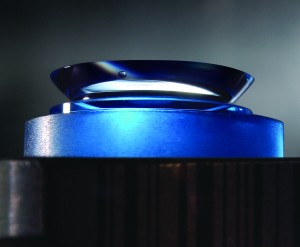We have all had the experience of fitting a pair of customized toric contact lenses only to discover that the orientation diagnostic markings are off axis – not aligned where they should be.
Diagnostic Markings: Each contact lens company uses different locations and different symbols for their diagnostic marks. SpecialEyes custom soft toric contact lenses have diagnostic marks located at three o’clock and nine o’clock. Upon slit lamp examination, these diagnostic marks take the appearance of small dots. Reference the images below for visual representation.

Diagnostic Mark

On-Eye Diagnostic Mark
My Preference: In my years of fitting customized soft toric contact lenses, I developed a preference for diagnostic marks located at 3 o’clock and 9 o’clock. The main reasons for this preference was that I could easily visualize a horizontal line or ruler between the marks and this made it easier for me to assess rotation and stability. Secondly, I did not have to manipulate the lower lid to visualize the diagnostic marks. When fitting customized toric contact lenses with a 6 o’clock diagnostic mark, I found there were many times when I had to manipulate the lower lid. This created a less than ideal scenario because sometimes lid manipulation affected the on-eye toric contact lens position, and therefore I was not able to accurately assess performance, fit, and rotation.
Golden Rule: A good rule of thumb is to always assess and correct the fit of the customized soft toric contact lens first before attempting to alter power. When assessing a custom soft toric contact lens on-eye and the patient’s visual acuity is being affected by rotation, one must first determine if the rotation is stable or unstable and obtain further information before reordering.
Stable Lens Rotation: If the lens rotation is stable and not fluctuating, the next step would be to determine how much the lens is rotated and in which direction. The acronym LARS is of great assistance in this situation. As most of us learned, LARS stands for Left Add Right Subtract. For example, If the lens is rotated to the left by 15 degrees, then we would add 15 degrees to the axis value of the custom toric contact lens. Remember though that the direction of the rotation is determined by the observer's right and left side, not from the anatomical position of the patient. Implementing LARS is a quick and effective method for addressing the stable rotation of a custom toric contact lens, but it does have its limitations. LARS does not take into account vertexing errors, lens draping effects, tear lens effects, cross-cylinder effects, etc. So if at all possible, and you have the available chair time, I would advocate for performing a sphero-cylindrical over-refraction when there is a stable lens rotation finding. SpecialEyes consultants are glad to incorporate a sphero-cylinderical over-refraction into the contact lens Rx for you, or you may choose to use the online SpecialEyes Over-Refraction Calculator and calculate the resultant Rx yourself. When using the calculator, do not be alarmed by the resultant Rx. Remember when a lens rotates off axis, one meridian may be over corrected while the other meridian may be under corrected.
Unstable/Fluctuating Rotation: If an equilibrated, customized toric contact lenses on the patient’s eye reveals unstable and fluctuating rotation, the fit must be altered and changed before changing the power or Rx of the custom toric contact lens. SpecialEyes Consultants are equipped and trained to assist you with the necessary fit changes or with any questions you may have. Please contact our knowledgeable consultants at 866-822-2020, or via the SpecialEyes online Consultation Request form.
Fitting Pearl: The take-away to remember when you are presented with rotated customized toric contact lenses is to first determine if the rotation is stable or unstable. Then define the amount and direction of the rotation. Also, if the rotation is stable and you have the chair time available, perform a sphero-cylindrical over-refraction. Lastly, contact us here at SpecialEyes and we would be glad to assist with a reorder.
Scott Davis, LDO, ABOC, NCLEC
Scott Davis, a licensed dispensing optician from the Massachusetts area, is a part of the SpecialEyes team and brings with him 45 years of experience within the contact lens industry.